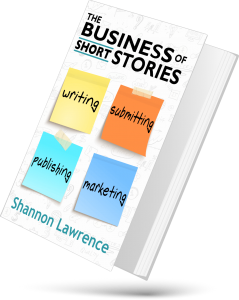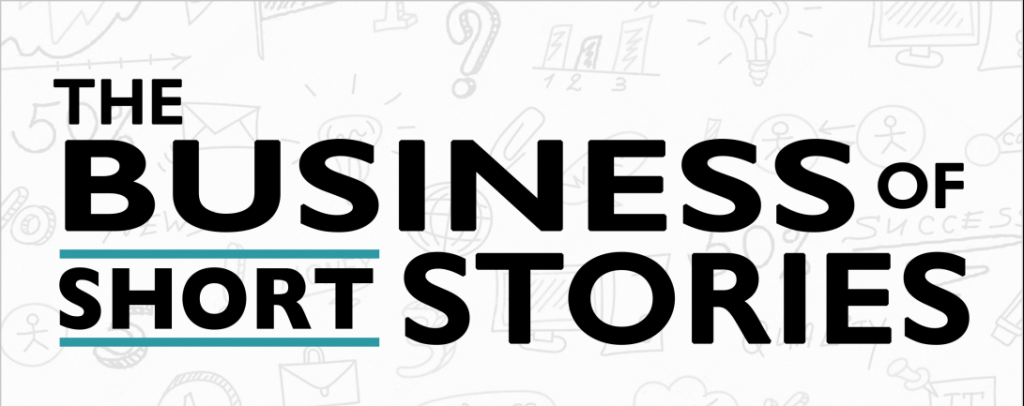Welcome to an interview with fellow author Shannon Lawrence! Previous interviews with Shannon for her short story collection Blue Sludge Blues and other interviews with Richard Bamberg, Rob Chansky, P.R. Adams, Megan Rutter, Jason Dias, and MJ Bell are also available.
The Business of Short Stories
Whether you’re looking to add short stories to your repertoire as a solo pursuit or in addition to novel writing, The Business of Short Stories covers every aspect from writing to marketing. Learn the dynamics of short story writing, where to focus your editing efforts, how and where to submit, how to handle acceptances and rejections, what to do with reprints, and how to market yourself and your stories online and in person. The information in The Business of Short Stories has been distilled from over a decade of short story publishing experience so you don’t have to learn the hard way. You’ll find information on submission formatting, cover letters, querying a collection, sending proposals to writing events, how to create a website, SEO, social media, and so much more. This is an invaluable resource for short story writers.
There’s never been a better time to get into short stories!
[Or see below the interview for a sample!]
I have known author Shannon Lawrence from the Colorado writing community for quite some time, and have loved her short horror fiction ever since I heard her read the title story from her collection Blue Sludge Blues. She is a powerhouse of writing and hustling her short fiction (among other talents), and I’m pleased to share this interview with her about her new book on writing, selling, marketing, and promoting short fiction, The Business of Short Stories.
Writing and publishing short fiction isn’t just a labor of love, but an awesome training ground for a career in fiction. The skillsets you learn as a short fiction writer–and which Shannon covers in her book–are the basis for successful fiction writing in general.
Learning how to sell your fiction is a key skill. Unfortunately, writers don’t get to just write their stories, even in the traditional publishing world.
Mastering the techniques Shannon describes will help you move forward with your whole writing career. It’s solid stuff (if not always romantic).
See below for the description and sample of The Business of Short Stories. It goes live on February 1, 2020.
1. You have written a LOT of short stories. How many have you written, total? What’s the guesstimate? And which one is your current favorite that you’ve written?…and which is your favorite that someone else wrote?
Oh, wow! That’s a tricky question. I imagine the number I’ve written is somewhere around 100. Probably more. There have been stories that were never meant to see the light of day and stories that just never have. I currently have over twenty out on submission.
My current favorite may never see publication, because it’s a light fantasy piece. It’s more emotion than anything else. It’s called Inked Soul. Of course, it may be that I’m submitting it to the wrong type of markets, so I’ll be switching it up soon. It has a lot personal to it, and it feels oddly beautiful to me.
I have so many favorites by others! But I’ll name one that most people will recognize in some way. The Tell-Tale Heart, by Edgar Allan Poe has been a favorite for so long, since I was a kid. The buildup is perfection. You’re watching a man lose it in real time, full of paranoia and smugness. He starts out confident in himself and what he’s done, but it eats at him the longer he sits there. So well done.
2. In your new book, you tell writers not just how to write a short story, but how to get started in a short story career. You covered a LOT. I kept trying to come up with things you hadn’t covered, and it would be literally the next chapter. So tell us which writers will be best served by your book, and what problem it solves for them. Basically, who should read this and why?
First of all, that’s awesome to hear. One of the things I did with my beta readers was to ask them to write down their questions before they read it, so that if there was something I hadn’t covered they could tell me. It’s too hard to remember what you wanted to know afterward unless it’s glaring.
The book is intended specifically for beginning writers, but it should appeal to intermediate writers, as well. For beginners, my intention is for them to not have to learn everything the hard way like you and I did. The focus is more on what comes after the writing, even though I do cover the dynamics of short story writing. I feel like the writing is such a personal thing that less of it can be taught compared to the rest of what writers need to know. Like how to find places to submit the stories and how to go about it. How to write a cover letter. What to do if you never hear back, or you hear back and it’s a rejection, an acceptance, or a rewrite request. What to expect after that. How to tie yourself into accounts that already exist to get the word out about books (BookBub, Amazon’s Author Central, Goodreads) so you can get anthologies and magazines connected with your name. Tips on social media and public appearances. Business tips, such as setting up a website and a separate email. I tried to cover as much as possible that would help set writers up for success so they wouldn’t have to scramble to make up ground or to change things that had been done incorrectly early on (you know, like I’ve had to do with some things, or had to just deal with on other things).
For intermediate writers, I was surprised about some of the things that weren’t common knowledge, so there are resources there for them, too. For them, it might work more as a checklist, to figure out what steps they might have missed and where to look. The marketing section is meant to serve as first steps for beginning writers, but also some deeper steps for folks who haven’t taken that big dive into marketing or need to make their next moves because they’ve learned the beginning steps. Even novelists can find helpful information in the marketing section, because I intended the information there to grow with writers/authors as they move forward in their careers. It helped that I have a background in booking speakers, so I could give feedback on that from both the perspective of an author making appearances and the staff facilitating those appearances.
3. What does your writing process tend to look like for short stories? And would you say you spend the most time writing, editing, marketing, or promoting your stories?
I tend to be a sprint writer and a panster, so I’ll go a period of time without writing until desire and time meet up just right. But when I do sit down to write, I can get a massive number of words down in one sitting. Short stories usually only take one to three sittings, but those sittings are several hours each. If they wallow there too long, I feel like it impacts the final product. (To be clear, this is just for my writing. Everyone writes differently.) A lot of my writing is done in front of a movie or with music playing. Though I’m noticing that silence is appealing to me more and more now, so that may be changing. It used to be that I couldn’t deal with a quiet room, even when working. Editing still needs to be done in silence, though, so even music can’t be playing.
I’d like to think I spend more time writing than anything else, but that balance sways sometimes. Luckily, I write pretty clean in terms of grammar, punctuation, etc., so my editing mostly comes down to content, wording, pacing, and that sort of thing. I read a lot of short stories, and I’ve now written enough of them that the rhythm of a short story comes more naturally, which means less editing on those aspects is required. At the very least, it means not having to spend a ton of time cutting down or building up to word count, so I can focus on the story itself.
Then again, right now most of my time is going into marketing, but some of that is updating and making long-term changes that will remain for a while. It also comes down to the difference between marketing short stories and marketing a book. Both involve having a consistent presence online, which I’d say takes more time than what we read as actual promotion, which is the visible push. But learning to preschedule and spend a limited time on marketing/promotion has helped with that, and I’m more comfortable with the time balance (when not launching a book).
4. Where do you feel most short story writers struggle the most? And what’s your top short advice to address that struggle?
I think marketing is the biggest issue, but when we skip that, the hardest thing is the actual submission process. I know SO many writers, but very few of them are actively submitting the short stories they write. I don’t believe that’s because they can’t figure out where to possibly submit, but because they lack confidence in themselves and their writing, so they simply don’t do it. And when they do, a single rejection may be the thing that derails them.
So my short advice is to submit. Period. Get yourself out there. What we tend to fear is rejection, because we’re human. It hurts. But the worst thing that’s going to happen is that an email will come in that says, in short, “No, thank you.” There’s no shame in getting a rejection. Turn that story right back around and resubmit it. Don’t let rejection beat you down. The more it happens, the easier it gets. Someone wants to read your writing. Many someones. So submit. Then submit again.
Random side note, but notice how the two hardest aspects typically come down to the two that require us to believe in ourselves? Marketing and submitting both mean believing in yourself enough to believe someone else will be interested, too. I’m here to tell you that they WILL.
5. What would you say is the best way for a writer to know that their work is ready to submit to a short story market? And does that mean their story is also ready to indie publish?
I believe in letting a story sit for a bit before coming back to it, so that it’s viewed with somewhat fresh eyes. If a writer lets that sit for whatever period they’re comfortable with and they come back to it and it reads well, is clean, has good flow, is nicely paced, and they would be happy to read it if it were someone else’s story, it’s ready. It helps to read it out loud or have a machine read it aloud, too. It also helps to get someone else’s eyes on it, such as in the case of a critique group or beta readers. But ultimately it comes down to reading it and thinking it reads well.
That second question is harder to answer. I know that I go over something more if I’m going to publish it without it having been through someone else. I can definitely say that if a writer doesn’t typically send a story out for feedback in one way or another, they should absolutely do so before they indie publish. The more feedback you get, the more you learn what to look for in your own writing. The industry looks a lot harder at indie published writers than they do traditionally published. Typos that are forgiven in a Stephen King novel will not be forgiven in an indie writer’s book, and it will be held up as a reason indie publishing isn’t valid. If you aren’t confident that you can edit yourself, hire an editor. They’re incredibly valuable. In fact, I recommend that nine times out of ten.
6. Is there any note you’d like to leave our readers on?
In addition to The Business of Short Stories I have three solo horror collections available on Amazon and from Kobo, Barnes & Noble, and other platforms: Blue Sludge Blues & Other Abominations, Bruised Souls & Other Torments, and Happy Ghoulidays. Plus, a true crime podcast with a sense of humor: Mysteries, Monsters, & Mayhem, which can be found on all podcast platforms, such as iHeartRadio, Spotify, Pandora, and others.
[Editor’s note: I love Shannon and M.B. Partlow’s podcast! Even if I am behind. I recommend it!]

Excerpt from Chapter 1: Defining the Short Story
Character, setting, and plot are just as vital in short stories as they are in novels. They are possibly even more important, because they must be used to immerse the reader in the story immediately. This doesn’t necessarily mean starting in the middle of physical action, which people often default to when they try to address creating an immediate hook. It means that the writer must find a creative way to introduce the reader to the main character quickly and give the reader a reason to keep reading. It might seem like a reader would give a short story an equivalent amount of time to get engaged as they would require from a novel, but this isn’t true. When someone sits down to read a short story, they expect to finish that story in one sitting, possibly with the idea of reading several short stories in a row. Which means they’ll put the story down faster if they don’t read something right away that makes them want to proceed.
The reader needs to be intrigued as soon as they start reading. This can be done by creating such an interesting character that they want to know more about them and what they’re about to face. This requires skipping the useless appearance descriptions and diving into the meat of the character, their skeletal structure. What makes them tick? Are they facing a moral dilemma, a crush, or a dangerous situation? Perhaps the story starts with the character caught up in trying to make a difficult decision. Maybe they’re fleeing something. It could also be that they’re funny and charming, and the reader wants to get to know them.
I’m speaking in the singular here, because that’s the best way to start out your short story writing. If you plan on having more than one important character (hopefully no more than two in this case or three if you’re stretching), you’ll have to introduce the other characters in rapid succession. If they pop up in the middle of the story, there had better be a good reason for doing so, and they must be introduced so the reader has an instant feel for them. A good way to introduce any character is through dialogue and actions. Presenting their current view through thoughts, observations, and reactions, whether thought or spoken, can be effective, as well. What this is doing is showing the reader who they’re dealing with and what that character is facing, rather than telling the reader. It’s an organic way to set the characterization right from the start, and hopefully draw the reader into their world.
The scene must also be set quickly. This can be done through the senses of the character and brief description. Don’t spend even a single paragraph on scene description. The introduction of the character, the setting, and even the conflict, at least in part, can be addressed right away through what is occurring in the now.
Using the senses to pull the reader in can help get to the meat more quickly, as well. It’s setting the scene in a few words. Brevity doesn’t mean dropping all description. If that description is helping to introduce a character, setting, or situation, it should be included, but kept brief and wrapped in with the rest of the text.
Addressing the conflict early on is another way to set up the story quickly and intrigue the reader right away. Making the conflict apparent also helps to set the tone and plot of the rest of the story, showing the reader what kind of ride they’re in for. To repeat myself once again, this doesn’t mean there has to be immediate physical action. What I mean by physical action is someone running or fighting or doing something physical that’s meant to get the reader’s heart pumping and flat out stick them in the middle of a fight or scary incident. Trying to do this often leads to an empty or useless scene that conveys little about the ultimate conflict or the character. There are all kinds of ways to get the reader’s heart pumping, whether through fear, excitement, or lust. It depends upon what kind of story they’ve signed on to read, but it should involve some kind of suspense.
Want to find out more? You’ll have to read the book!

Shannon Lawrence has made a career of short stories, with over a decade of experience and more than fifty short stories published in magazines and anthologies. In addition, she’s released three horror short story collections with a mix of new and previously published stories. Her true crime podcast Mysteries, Monsters, & Mayhem is going into its third season.
Website: www.thewarriormuse.com
Facebook: https://www.facebook.com/thewarriormuse
Twitter: https://twitter.com/thewarriormuse
Instagram: https://www.instagram.com/thewarriormuse/
BookBub: https://www.bookbub.com/profile/shannon-lawrence
Goodreads: https://www.goodreads.com/shannondkl
Amazon: https://www.amazon.com/Shannon-Lawrence/e/B00TDKPOAO
Podcast Website: www.mysteriesmonstersmayhem.com



Thank you for hosting me today, DeAnna! And for the great questions.